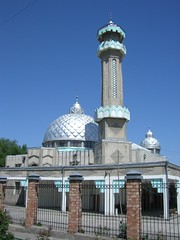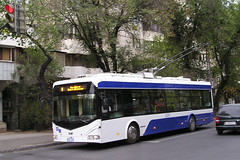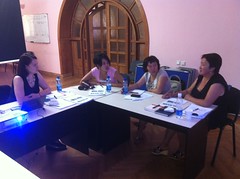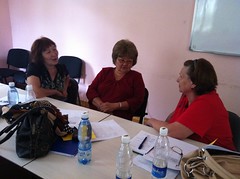Gorod Bishkek
Bishkek (Kyrgyz: Бишкек, Kyrgyz: [biʃˈkek]), formerly Pishpek and Frunze, is the capital and largest city of Kyrgyzstan. Bishkek is also the administrative centre of the Chüy Region. The region surrounds the city, although the city itself is not part of the region but rather a region-level unit of Kyrgyzstan. Bishkek is situated near the Kazakhstan–Kyrgyzstan border. Its population was 1,074,075 in 2021.
In 1825, the Khanate of Kokand established the fortress of Pishpek to control local caravan routes and to collect tribute from Kyrgyz tribes. On 4 September 1860, with the approval of the Kyrgyz, Russian forces led by Colonel Apollon Zimmermann destroyed the fortress. In the present day, the fortress ruins can be found just north of Jibek jolu street, near the new main mosque. In 1868, a Russian settlement was established on the site of the fortress under its original name, Pishpek. It lay within the General Governorship of Russian Turkestan and its Semirechye Oblast.
In 1925, the Kara-Kirghiz Autonomous Oblast was established in Russian Turkestan, promoting Pishpek to its capital. In 1926, the Communist Party of the Soviet Union renamed the city Frunze, after Bolshevik military leader Mikhail Frunze (1885–1925), who was born there. In 1936, Frunze became the capital of the Kirghiz Soviet Socialist Republic, during the final stages of national delimitation in the Soviet Union. In 1991, the Kyrgyz parliament changed the capital's name to Bishkek.
Bishkek is situated at an altitude of about , just off the northern fringe of the Kyrgyz Ala-Too Range, an extension of the Tian Shan mountain range. These mountains rise to a height of . North of the city, a fertile and gently undulating steppe extends far north into neighbouring Kazakhstan. The river Chüy drains most of the area. Bishkek is connected to the Turkestan–Siberia Railway by a spur line.
Bishkek is a city of wide boulevards and marble-faced public buildings combined with numerous Soviet-style apartment blocks surrounding interior courtyards. There are also thousands of smaller, privately built houses, mostly outside the city centre. Streets follow a grid pattern, with most flanked on both sides by narrow irrigation channels, which provide water to trees which provide shade during the hot summers.
Etymology
Bishkek is supposedly named after the paddle used to churn the fermenting milk.
The official website of the Bishkek's city hall provides the following etymological justification for the name of the city: the pregnant wife of a heo) lost a paddle used to churn kumis. While looking for it, she suddenly gave birth to a boy, who she named Bishkek. Bishkek would grow up to be a noble figure and after his death, was buried on a mound near the banks of the Alamüdün. There, a tombstone was erected. The building was seen and described by travelers of the 17th and 18th centuries.
History
Based on DNA evidence, the area near Bishkek is considered one of the possible origins of the Black Death between AD 1346 and 1353.
Kokhand rule
Originally a caravan rest stop, possibly founded by the Sogdians, on one of the branches of the Silk Road through the Tian Shan range, the location was fortified in 1825 by the khan of Kokand with a mud fort. In the last years of Kokhand rule, the Pishpek fortress was led by Atabek, the Datka. In 1844, the forces of Ormon Khan, the leader of the , briefly captured the fortress.
Tsarist era
In 1860, Imperial Russia annexed the area, and the military forces of Colonel took and razed the fort. Colonel Zimmermann rebuilt the town over the destroyed fort and appointed field-Poruchik Titov as head of a new Russian garrison. The Imperial Russian government redeveloped the site from 1877 onward, encouraging the settlement of Russian peasants by giving them fertile land to develop.
Soviet era
In 1926, the city became the capital of the newly established Kirghiz ASSR and was renamed Frunze after Mikhail Frunze, Lenin's close associate who was born in Bishkek and played key roles during the revolutions of 1905 and 1917 and during the Russian Civil War of the early 1920s.
Independence era
The early 1990s were a tumultuous time for Bishkek. In June 1990, a state of emergency was declared following severe ethnic riots in southern Kyrgyzstan that threatened to spread to the capital. The city was renamed Bishkek on 5 February 1991, and Kyrgyzstan achieved independence later that year during the breakup of the Soviet Union. Before independence, the majority of Bishkek's population were ethnic Russians. In 2004, Russians made up approximately 20% of the city's population, and about in 2011.
Bishkek is Kyrgyzstan's financial centre, with all of the country's 21 commercial banks headquartered there. During the Soviet era, the city was home to many industrial plants, but most have been shut down since 1991 or now operate on a much-reduced scale. One of Bishkek's largest employment centres today is the Dordoy Bazaar open market, where many of the Chinese goods imported to CIS countries are sold.
Geography
Orientation
Although Bishkek itself is relatively young, its surrounding area has some sites of interest dating to prehistoric times. There are also sites from the Greco-Buddhist period, the period of Nestorian influence, the era of the Central Asian khanates, and the Soviet period.
The central part of the city is laid out on a rectangular grid plan. The city's main street is the east-west Chüy Avenue (Chüy Prospekti), named after the region's main river. In the Soviet era, it was called Lenin Avenue. Along or near it are many important government buildings and universities. These include the Academy of Sciences compound. The westernmost section of the avenue is known as Deng Xiaoping Avenue.
The main north–south street is Yusup Abdrakhmanov Street, still commonly referred to by its old name, Sovietskaya Street. Its northern and southern sections are called, respectively, Yelebesov and Baityk Batyr Streets. Several major shopping centres are located along with it, and in the north, it provides access to Dordoy Bazaar.
Erkindik ("Freedom") Boulevard runs from north to south, from the main railroad station (Bishkek II) south of Chüy Avenue to the museum quarter and sculpture park just north of Chüy Avenue, and further north toward the Ministry of Foreign Affairs. In the past, it was called Dzerzhinsky Boulevard, named after a Communist revolutionary, Felix Dzerzhinsky, and its northern continuation is still called Dzerzhinsky Street.
An important east–west street is Jibek Jolu ('Silk Road'). It runs parallel to Chüy Avenue about north of it and is part of the main east–west road of Chüy Region. Both the eastern and western bus terminals are located along Jibek Jolu.
There is a Roman Catholic church located at ul. Vasiljeva 197 (near Rynok Bayat). It is the only Catholic cathedral in Kyrgyzstan.
A stadium named in honour of Dolon Omurzakov is located near the centre of Bishkek. This is the largest stadium in the Kyrgyz Republic.
City centre
- Kyrgyz State Historical Museum, located in Ala-Too Square, the main city square.
- State Museum of Applied Arts, containing examples of traditional Kyrgyz handicrafts.
- Frunze House Museum.
- Statue of Ivan Panfilov in the park near the White House.
- An equestrian statue of Mikhail Frunze stands in a large park (Boulevard Erkindik) across from the train station.
- The train station was built in 1946 by German prisoners of war and has survived since then without further renovation or repairs; most of those who built it perished and were buried in unmarked pits near the station.
- The main government building, the White House, is a large seven-story marble building and the former headquarters of the Communist Party of the Kirghiz SSR.
- At Ala-Too Square there is an independence monument where the changing of the guards may be watched.
- Osh Bazaar, west of the city centre, is a large, picturesque produce market.
- Kyrgyz National Philharmonic, concert hall.
Outer neighbourhoods
The Dordoy Bazaar, just inside the bypass highway on the north-eastern edge of the city, is a major retail and wholesale market.
Outside the city
The Kyrgyz Ala-Too mountain range, some away, provides a spectacular backdrop to the city; the Ala Archa National Park is only a 30 to 45 minutes drive away.
Distances
Bishkek is about 300 km away directly from the country's second largest city Osh. However, its nearest large city is Almaty of Kazakhstan, which is 190 km to the east. Furthermore, it is 470 km from Tashkent (Uzbekistan), 680 km from Dushanbe (Tajikistan), and about 1,000 km each from Astana (Kazakhstan), Ürümqi (China), Islamabad (Pakistan), and Kabul (Afghanistan).
Demographics
Bishkek is the most populated city in Kyrgyzstan. Its population, estimated in 2021, was 1,074,075. From the foundation of the city to the mid-1990s, ethnic Russians and other peoples of European descent (Ukrainians, Germans) comprised the majority of the city's population. According to the 1970 census, the ethnic Kyrgyz were only 12.3%, while Europeans comprised more than 80% of the Frunze population. Now Bishkek is a predominantly Kyrgyz city, with 75% of its residents Kyrgyz, while European peoples make up around 15% of the population. Despite this fact, Russian is the main language while Kyrgyz continues losing ground, especially among the younger generations.
Ecology and environment
Air quality
Emissions of air pollutants in Bishkek amounted to 14,400 tons in 2010. Among all cities in Kyrgyzstan, the level of air pollution in Bishkek is the highest, occasionally exceeding maximum allowable concentrations by several times, especially in the city centre. For example, concentrations of formaldehyde occasionally exceed maximum allowable limits by a factor of four.
Responsibility for ambient air quality monitoring in Bishkek lies with the Kyrgyz State Agency of Hydrometeorology. There are seven air-quality monitoring stations in Bishkek, measuring levels of sulfur dioxide, nitrogen oxides, formaldehyde, …
Looking for places related to Gorod Bishkek?
Those are other destinations to find places related to Gorod Bishkek:

















